Geography of Russia
 | |
| Continent | Europe and Asia |
|---|---|
| Region | Eastern Europe (European Russia) Northern Asia (Siberia) |
| Coordinates | recognised] as a part of Ukraine. 60.000°N 100.000°E] |
| Area | |
| • Land | 95.78% |
| • Water | 4.22% |
| Coastline | 37,654 km (23,397 mi) |
| Borders | Poland 204.1 km (126.8 mi) Lithuania 266 km (165 mi) |
| Highest point | Mount Elbrus 5,642 m (18,510 ft) |
| Lowest point | Caspian Sea, −28 m (−92 ft) |
| Longest river | Yenisei–Angara–Selenge, 5,539 km (3,442 mi) |
| Largest lake | Lake Baikal 31,722 km2 (12,248 sq mi) |
| Climate | European Russia and Siberia: mostly cool climate Extreme north: tundra Extreme southeast: temperate continental |
| Terrain | Most of Russia consists of two plains (the East European Plain and the West Siberian Plain), two lowlands (the North Siberian and the Kolyma, in far northeastern Siberia), two plateaus (the Central Siberian Plateau and the Lena Plateau to its east), and a series of mountainous areas mainly concentrated in the extreme northeast or extending intermittently along the southern border. |
| Natural resources | Oil, gas, coal, timber, metals, diamonds, copper, lead, zinc, bauxite, nickel, tin, mercury, gold, silver, platinum, titanium, manganese, potash, uranium, cobalt, molybdenum, tungsten, aluminum, polymetals, chromium, phosphates, apatites, talc, asbestos, mica, salt, amber, precious and semiprecious stones, sand, clay, limestone, marble, granite, iron ore, arable land, tobacco, tea, citrus fruit, hydroelectricity, fresh water, fruits, and vegetables. |
| Natural hazards | Earthquakes, landslides, storms, hurricanes, forest fires, and floods. |
| Environmental issues | Deforestation, energy irresponsibility, pollution, and nuclear waste. |
| Exclusive economic zone | 7,566,673 km2 (2,921,509 sq mi) |
Russia (Russian: Россия) is the largest country in the world, covering over 17,125,192 km2 (6,612,074 sq mi), and encompassing more than one-eighth of Earth's inhabited land area. Russia extends across eleven time zones, and has the most borders of any country in the world, with sixteen sovereign nations.[lower-alpha 2]
Russia is a transcontinental country stretching vastly over two continents, Europe and Asia.[1] It spans the northernmost edge of Eurasia, and has the world's fourth-longest coastline, at 37,653 km (23,396 mi).[lower-alpha 3][3] Russia, alongside Canada and the United States, is one of only three countries with a coast along three oceans (however connection to the Atlantic Ocean is extremely remote),[1] due to which it has links with over thirteen marginal seas.[lower-alpha 4][4] It lies between latitudes 41° and 82° N, and longitudes 19° E and 169° W. Russia is larger than three continents of the world,[lower-alpha 5] and has about the same surface area as Pluto.[6]
Global position and boundaries
_(Russia_centered).svg.png.webp)
Kaliningrad Oblast, westernmost part of Russia along the Baltic Sea, is about 9,000 km (5,600 mi) apart from its easternmost part, Big Diomede Island in the Bering Strait.[4] This distance spans about 6,800 kilometres (4,200 mi), to Nome, Alaska. From north to south, the country ranges from the northern tip of the Russian Arctic islands at Franz Josef Land to the southern tip of the Republic of Dagestan on the Caspian Sea, spanning about 4,500 kilometres (2,800 mi) of extremely varied, often inhospitable terrain.
Extending for 57,792 kilometres (35,910 mi), the Russian border is the world's longest. Along the 20,139-kilometre land frontier, Russia has boundaries with 14 countries: Poland and Lithuania (both via Kaliningrad Oblast), Norway, Finland, Estonia, Latvia, Belarus, Ukraine, Georgia, Azerbaijan, Kazakhstan, China, Mongolia, and North Korea.
Approximately two-thirds of the frontier is bounded by seawater. Virtually all of the lengthy northern coast is well above the Arctic Circle; except for the port of Murmansk—which receives currents that are somewhat warmer than would be expected at that latitude, due to the effects of the Gulf Stream—that coast is locked in ice much of the year. Thirteen seas and parts of two oceans—the Arctic and Pacific—wash Russian shores. It is separated by close sea, making it a maritime boundary. It also shares one with Japan.
Administrative and territorial divisions
With a few changes of status, most of the Soviet Union's administrative and territorial divisions of the Russian Republic were retained in constituting the Russian Federation. As of 2014, there were eighty-five administrative territorial divisions (called federal subjects): twenty-two republics, nine krais (territories), forty-six oblasts (provinces), one autonomous oblast, four autonomous okrugs, and three cities with federal status, namely the cities of Moscow, Saint Petersburg, and Sevastopol.
The republics include a wide variety of peoples, including northern Europeans, Tatars, Caucasus peoples, and indigenous Siberians. The largest federal subjects are in Siberia. Located in east-central Siberia, the Sakha Republic (Yakutia) is the largest federal subject in the country (and the largest country subdivision in the world), twice the size of Alaska. Second in size is Krasnoyarsk Krai, located west of Sakha in Siberia. Kaliningrad Oblast, which is a noncontiguous constituent entity of Russia, is the smallest oblast. The Republic of Ingushetia is both the smallest republic and the smallest federal subject of Russia except for the three federal cities. The two most populous federal subjects, Moscow Oblast (with Moscow) and Krasnodar Krai, are in European Russia.
Human geography
Demographics
Russia had a population of 142.8 million according to the 2010 census,[7] which rose to 146.2 million as of 2021 following the annexation of Crimea in 2014.[8] It is the most populous country in Europe, and the ninth-most populous country in the world; with a population density of 9 inhabitants per square kilometre (23 inhabitants/sq mi).[9]
Urban areas
 Moscow, the capital and largest city of Russia
Moscow, the capital and largest city of Russia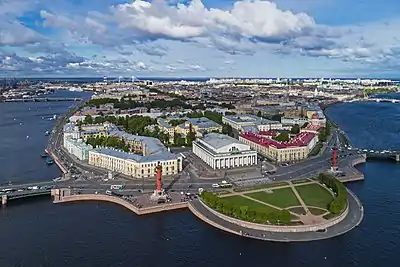 Saint Petersburg, the cultural capital and the second-largest city
Saint Petersburg, the cultural capital and the second-largest city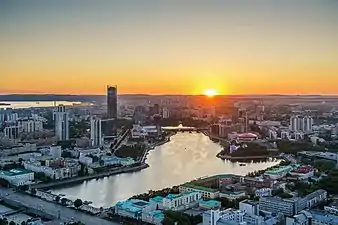 Yekaterinburg, the fourth-largest city in the country.
Yekaterinburg, the fourth-largest city in the country.
Russia is one of the world's most urbanized countries, with roughly 75% of its total population living in urban areas.[10] Moscow, the capital and largest city, has a population estimated at 12.4 million residents within the city limits,[11] while over 17 million residents in the urban area,[12] and over 20 million residents in the metropolitan area.[13] Moscow is among the world's largest cities, being the most populous city entirely within Europe, the most populous urban area in Europe,[12] the most populous metropolitan area in Europe,[13] and also the largest city by land area on the European continent.[14] Saint Petersburg, the cultural capital, is the second-largest city, with a population of roughly 5.4 million inhabitants.[15] Other major urban areas are Yekaterinburg, Novosibirsk, Kazan, Nizhny Novgorod, and Chelyabinsk.
| Rank | Name | Federal subject | Pop. | Rank | Name | Federal subject | Pop. | ||
|---|---|---|---|---|---|---|---|---|---|
 Moscow  Saint Petersburg |
1 | Moscow | Moscow | 13,010,112 | 11 | Rostov-on-Don | Rostov Oblast | 1,142,162 | 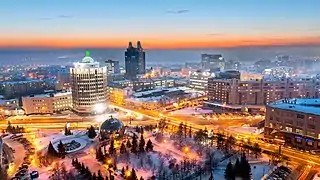 Novosibirsk  Yekaterinburg |
| 2 | Saint Petersburg | Saint Petersburg | 5,601,911 | 12 | Omsk | Omsk Oblast | 1,125,695 | ||
| 3 | Novosibirsk | Novosibirsk Oblast | 1,633,595 | 13 | Krasnodar | Krasnodar Krai | 1,099,344 | ||
| 4 | Yekaterinburg | Sverdlovsk Oblast | 1,544,376 | 14 | Voronezh | Voronezh Oblast | 1,057,681 | ||
| 5 | Kazan | Tatarstan | 1,308,660 | 15 | Perm | Perm Krai | 1,034,002 | ||
| 6 | Nizhny Novgorod | Nizhny Novgorod Oblast | 1,228,199 | 16 | Volgograd | Volgograd Oblast | 1,028,036 | ||
| 7 | Chelyabinsk | Chelyabinsk Oblast | 1,189,525 | 17 | Saratov | Saratov Oblast | 901,361 | ||
| 8 | Krasnoyarsk | Krasnoyarsk Krai | 1,187,771 | 18 | Tyumen | Tyumen Oblast | 847,488 | ||
| 9 | Samara | Samara Oblast | 1,173,299 | 19 | Tolyatti | Samara Oblast | 684,709 | ||
| 10 | Ufa | Bashkortostan | 1,144,809 | 20 | Barnaul | Altai Krai | 630,877 | ||
Physiography and hydrography
Geographers traditionally divide the vast territory of Russia into five natural zones: the tundra zone; the Taiga, or forest, zone; the steppe, or plains, zone; the arid zone; and the mountain zone. Most of Russia consists of two plains (the East European Plain and the West Siberian Plain), three lowlands (the North Siberian, the Central Yakutian and the East Siberian), two plateaus (the Central Siberian Plateau and the Lena Plateau), and two systems of mountainous areas (the East Siberian Mountains in far northeastern Siberia and the South Siberian Mountains along the southern border).
Ecoregions
 The wider area of the Urals, showing the transition of temperate forest, taiga, steppe and semi-desert
The wider area of the Urals, showing the transition of temperate forest, taiga, steppe and semi-desert desert
desert
tundra
alpine tundra
taiga
forest
temperate broadleaf forest
temperate steppe
steppe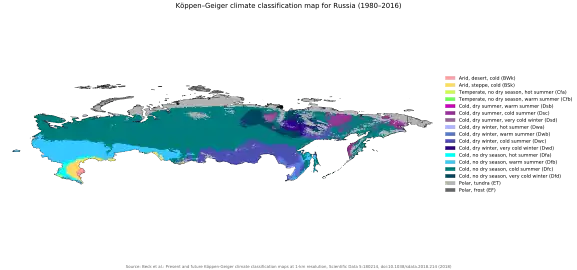 Köppen climate types of Russia
Köppen climate types of Russia
East European plain
The East European Plain encompasses most of European Russia. The West Siberian Plain, which is the world's largest, extends east from the Urals to the Yenisei River. Because the terrain and vegetation are relatively uniform in each of the natural zones, Russia presents an illusion of uniformity. Nevertheless, Russian territory contains all the major vegetation zones of the world except a tropical rain forest.
Icecaps
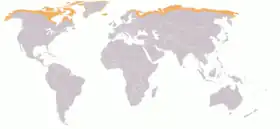

The Russian Arctic stretches for close to 7,000 kilometres (4,300 mi) west to east, from Karelia and the Kola Peninsula to Nenetsia, the Gulf of Ob, the Taymyr Peninsula and the Chukchi Peninsula (Kolyma, Anadyr River, Cape Dezhnev). Russian islands and archipelagos in the Arctic Sea include Novaya Zemlya, Severnaya Zemlya, and the New Siberian Islands.
About 10 percent of Russia is tundra[17]—a treeless, marshy plain. The tundra is Russia's northernmost zone, stretching from the Finnish border in the west to the Bering Strait in the east, then running south along the Pacific coast to the northern Kamchatka Peninsula. The zone is known for its herds of wild reindeer, for so-called white nights (dusk at midnight, dawn shortly thereafter) in summer, and for days of total darkness in winter. The long, harsh winters and lack of sunshine allow only mosses, lichens, and dwarf willows and shrubs to sprout low above the barren permafrost. Although several powerful Siberian rivers traverse this zone as they flow northward to the Arctic Ocean, partial and intermittent thawing hamper drainage of the numerous lakes, ponds, and swamps of the tundra. Frost weathering is the most important physical process here, gradually shaping a landscape that was severely modified by glaciation in the last ice age. Less than one percent of Russia's population lives in this zone. The fishing and port industries of the northwestern Kola Peninsula and the huge oil and gas fields of northwestern Siberia are the largest employers in the tundra. With a population of 180,000, the industrial frontier city of Norilsk is second in population to Murmansk among Russia's settlements above the Arctic Circle. From here you can also see the auroras (northern lights).
Taiga
Taiga, the most extensive natural area of Russia, stretches from the western borders of Russia to the Pacific. It occupies the territory of the Eastern Europe and West Siberian plains to the north of ° N and most of the territory east of Yenisei River taiga forests reach the southern borders of Russia in Siberia taiga only accounts for over 60% of Russia. In the north–south direction the eastern taiga is divided (east of the Yenisei River), with a continental climate, and west, with a milder climate, in general, the climate zone is moist, moderately warm (cool in the north) in the summer and harsh winter, there is a steady snow cover in the winter. In the latitudinal direction, the taiga is divided into three subzones - northern, middle and southern taiga. In the western taiga dense spruce and fir forests on wetlands alternate with pine forests, shrubs, and meadows on the lighter soils. Such vegetation is typical of the eastern taiga, but it plays an important role not fir and larch. Coniferous forest, however, does not form a continuous array and sparse areas of birch, alder, willow (mainly in river valleys), the wetlands - marshes. Within the taiga are widespread fur-bearing animals - sable, marten, ermine, moose, brown bear, Wolverine, wolf, and muskrat.[18]
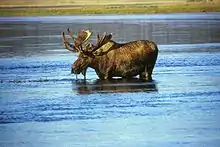
In the taiga is dominated by podzolic and cryogenic taiga soils, characterized by clearly defined horizontal structure (only in the southern taiga there is sod-podzolic soil). Formed in a leaching regime and in poor humus. Groundwater is normally found in the forest close to the surface, washing calcium from the upper layers, resulting in the top layer of soil of the taiga being discolored and oxidized. Few areas of the taiga, suitable for farming, are located mainly in the European part of Russia. Large areas are occupied by sphagnum marshes (here is dominated by podzolic-boggy soil). To enrich the soil for agricultural purposes lime and other fertilizers should be used.
Russian Taiga has the world's largest reserves of coniferous wood, but from year to year - as a result of intensive logging - they decrease. Development of hunting, farming (mainly in river valleys).
Mixed and deciduous forests
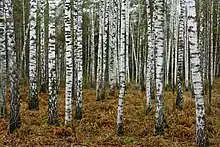
The mixed and deciduous forest belt is triangular, widest along the western border and narrower towards the Ural Mountains. The main trees are Oak and Spruce, but many other growths of vegetation such as ash, aspen, birch, hornbeam, maple, and pine reside there. Separating the taiga from the wooded steppe is a narrow belt of birch and aspen woodland located east of the Urals as far as the Altay Mountains. Much of the forested zone has been cleared for agriculture, especially in European Russia. Wildlife is more scarce as a result of this, but the roe deer, wolf, fox, and squirrel are very common.
Steppe
The steppe has long been depicted as the typical Russian landscape. It is a broad band of treeless, grassy plains, interrupted by mountain ranges, extending from Hungary across Ukraine, southern Russia, and Kazakhstan before ending in Manchuria. In a country of extremes, the steppe zone provides the most favorable conditions for human settlement and agriculture because of its moderate temperatures and normally adequate levels of sunshine and moisture. Even here, however, agricultural yields are sometimes adversely affected by unpredictable levels of precipitation and occasional catastrophic droughts. The soil is very dry.
Topography
.jpg.webp)
Russia's mountain ranges are located principally along its continental dip (the Ural Mountains), along the southwestern border (the Caucasus), along the border with Mongolia (the eastern and western Sayan Mountains and the western extremity of the Altay Mountains), and in eastern Siberia (a complex system of ranges in the northeastern corner of the country and forming the spine of the Kamchatka Peninsula, and lesser mountains extending along the Sea of Okhotsk and the Sea of Japan). Russia has nine major mountain ranges. In general, the eastern half of the country is much more mountainous than the western half, the interior of which is dominated by low plains. The traditional dividing line between the east and the west is the Yenisei River valley. In delineating the western edge of the Central Siberian Plateau from the West Siberian Plain, the Yenisey runs from near the Mongolian border northward into the Arctic Ocean west of the Taymyr Peninsula.
Ural Mountains
The Ural Mountains form the natural boundary between Europe and Asia; the range extends about 2,100 kilometres (1,300 mi) from the Arctic Ocean to the northern border of Kazakhstan. Several low passes provide major transportation routes through the Urals eastward from Europe. The highest peak, Mount Narodnaya, is 1,894 metres (6,214 ft). The Urals also contain valuable deposits of minerals.
West Siberian Plain
To the east of the Urals is the West Siberian Plain, stretching about 1,900 kilometers from west to east and about 2,400 kilometers from north to south. With more than half its territory below 200 meters in elevation, the plain contains some of the world's largest swamps and floodplains. The plain is largely flat and featureless. The only slightly elevated areas are the Siberian Uvaly across the central part and the Ob Plateau in the south.[19] There are steppe areas in the southern part reaching into Kazakhstan, such as the Ishim Steppe with the Kamyshlov Log trench. Most of the plain's population lives in the drier section south of 77 north latitude.
Central Siberian plateau
The region directly east of the West Siberian Plain is the Central Siberian Plateau, which extends eastward from the Yenisei River valley to the Lena River valley. The region is divided into several plateaus, with elevations ranging between 320 and 740 meters; the highest elevation is about 1,800 meters, in the northern Putoran Mountains. The plain is bounded on the south by the Primorsky Range and the Baikal Mountains, and on the north by the North Siberian Lowland, an extension of the West Siberian Plain extending into the Taymyr Peninsula on the Arctic Ocean.
Sayan and Stanovoy Mountains
In the mountain system west of Lake Baikal in south-central Siberia, the highest elevations are 3,300 meters in the Western Sayan, 3,200 meters in the Eastern Sayan, and 4,500 meters at Belukha Mountain in the Altay Mountains. The Eastern Sayan reach nearly to the southern shore of Lake Baikal; at the lake, there is an elevation difference of more than 4,500 meters between the nearest mountain, 2,840 meters high, and the deepest part of the lake, which is 1,700 meters below sea level. The mountain systems east of Lake Baikal are lower, forming a complex of minor ranges and valleys that reaches from the lake to the Pacific coast. The maximum height of the Stanovoy Range, which runs west to east from northern Lake Baikal to the Sea of Okhotsk, is 2,550 meters. To the south of that range is southeastern Siberia, whose mountains reach 800 meters. Across the Strait of Tartary from that region is Sakhalin Island, Russia's largest island, where the highest elevation is about 1,700 meters. The small Moneron Island, the site of the shootdown of Korean Air Lines Flight 007, is found to its west.
Caucasus Mountains
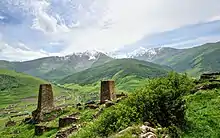
Truly alpine terrain appears in the southern mountain ranges. Between the Black and Caspian seas, the Caucasus Mountains rise to impressive heights, forming a boundary between Europe and Asia. One of the peaks, Mount Elbrus, is the highest point in Europe, at 5,642 meters. The geological structure of the Caucasus extends to the northwest as the Crimean and Carpathian Mountains and southeastward into Central Asia as the Tian Shan and Pamirs. The Caucasus Mountains create an imposing natural barrier between Russia and its neighbors to the southwest, Georgia and Azerbaijan.
Northeast Siberia and Kamchatka
Northeastern Siberia, north of the Stanovoy Range, is an extremely mountainous region. The long Kamchatka Peninsula, which juts southward into the Sea of Okhotsk, includes many volcanic peaks, some of which are still active. The highest is the 4,750-meter Klyuchevskaya Sopka, the highest point in the Russian Far East. The volcanic chain continues from the southern tip of Kamchatka southward through the Kuril Islands chain and into Japan. Kamchatka also is one of Russia's two centers of seismic activity (the other is the Caucasus). In 1995, a major earthquake largely destroyed the oil-processing town of Neftegorsk. Also located in this region is the very large Beyenchime-Salaatin crater.
Drainage
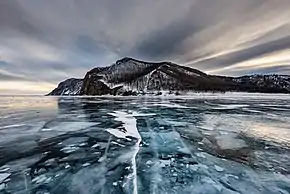
Russia, home to over 100,000 rivers,[1] is divided into twenty watershed districts. It has one of the world's largest surface water resources, with its lakes containing approximately one-quarter of the world's liquid fresh water.[20] Russia is second only to Brazil by total renewable water resources.[21]
Forty of Russia's rivers longer than 1,000 kilometers are east of the Ural Mountains, including the three major rivers that drain Siberia as they flow northward to the Arctic Ocean: the Irtysh-Ob system (totaling 5,380 kilometers), the Yenisey (5,075 kilometers), and the Lena (4,294 kilometers), they are among the world's longest rivers.[22] The basins of those river systems cover about eight million square kilometers, discharging nearly 50,000 cubic meters of water per second into the Arctic Ocean. The northward flow of these rivers means that source areas thaw before the areas downstream, creating vast swamps such as the 48,000-square-kilometer Vasyugan Swamp in the center of the West Siberian Plain. The same is true of other river systems, including the Pechora and the Northern Dvina in western Russia, and the Kolyma and the Indigirka in Siberia. Approximately 10 percent of Russian territory is classified as swampland.
Russia's inland bodies of water are chiefly a legacy of extensive glaciation. Ladoga and Onega in northwestern Russia are two of the largest lakes in Europe.[1] However, Lake Baikal is the largest and most prominent among Russia's fresh water bodies, is the world's deepest, purest, oldest and most capacious fresh water lake, containing over one-fifth of the world's fresh surface water.[23] Numerous smaller lakes dot northern Russia and Siberian plains. The largest of these are lakes Belozero, Topozero, Vygozero, and Ilmen in the country's northwest and Lake Chany in southwestern Siberia.
A number of other rivers drain Siberia from eastern mountain ranges into the Pacific Ocean. The Amur River and its main tributary, the Ussuri, form a long stretch of the winding boundary between Russia and China. The Amur system drains most of southeastern Siberia. Three basins drain European Russia. The Dnieper, which flows mainly through Belarus and Ukraine, has its headwaters in the hills west of Moscow. The 1,860-kilometer Don, which is the fifth-longest river in Europe, originates in the Central Russian Upland south of Moscow and then flows into the Sea of Azov at Rostov-on-Don. The Volga, widely seen as Russia's national river due to its historical and cultural importance, is the longest river in Europe,[22] it rises in the Valdai Hills west of Moscow and meandering southeastward for 3,510 kilometers before emptying into the Caspian Sea. Altogether, the Volga system drains about 1.4 million square kilometers. Linked by several canals, western Russia's rivers long have been a vital transportation system; the Volga remains the country's most commercial river, and carries about two-thirds of Russia's inland water traffic.
Agriculture geography
One billion acres of land is arable in Russia, but only about 0.1 percent is permanent agriculture.[24] The landscapes of region have extremely varied environments because of the following:
- Tundra landscapes cover most of the region, where conditions are harsh because of the cold climates, and plant life is not very well supported to grow because of the harsh conditions. This has become a problem, as the unfavorable conditions make agriculture more difficult.
- Mountain ranges are spread through the region, such as the Ural Mountains, which have become the dividing line between European Russia and Eurasian Russia.
- European Russia also has the European plains which extend about 2,000 miles.
The workforce involved in agriculture workforce was reported to be about 9.4% of the population in 2016.[25]
The main export of Russia is grain, which is about 6% of the world trade. Other exported products include fish and oil with 3%, meals with 2%, and meat which accounts for less than 1%.[26]
Pre-industrial agriculture
Agriculture has always been important for Russia. The land was worked by its peasant class.[27]
Climate

The sheer size of Russia and the remoteness of many areas from the sea result in the dominance of the humid continental climate, which is prevalent in all parts of the country except for the tundra and the extreme southwest. Mountains in the south and east obstruct the flow of warm air masses from the Indian and Pacific oceans, while the plain of the west and north makes the country open to Arctic and Atlantic influences. Most of Northwest Russia and Siberia has a subarctic climate, with extremely severe winters in the inner regions of Northeast Siberia (mostly Sakha, where the Northern Pole of Cold is located with the record low temperature of −71.2 °C or −96.2 °F),[29] and more moderate winters elsewhere. Russia's vast stretch of land along the Arctic Ocean and the Russian Arctic islands have a polar climate.[30]
The coastal part of Krasnodar Krai on the Black Sea, most notably Sochi, and some coastal and interior strips of the North Caucasus possess a humid subtropical climate with mild and wet winters. In many regions of East Siberia and the Russian Far East, winter is dry compared to summer; while other parts of the country experience more even precipitation across seasons. Winter precipitation in most parts of the country usually falls as snow. The westernmost parts of Kaliningrad Oblast on the Vistula Spit, and some parts in the south of Krasnodar Krai and the North Caucasus have an oceanic climate. The region along the Lower Volga and Caspian Sea coast, as well as some southernmost silvers of Siberia, possess a semi-arid climate.[28]
Throughout much of the territory, there are only two distinct seasons—winter and summer—as spring and autumn are usually brief periods of change between extremely low and extremely high temperatures.[30] The coldest month is January (February on the coastline); the warmest is usually July. Great ranges of temperature are typical. In winter, temperatures get colder both from south to north and from west to east. Summers can be quite hot, even in Siberia.[31]
Area and boundaries
Area (excluding Crimea):
- Total: 17,098,242 km2
- Land: 17,021,900 km2
- Water: 79,400 km2
Area - comparative:
Slightly larger than twice the size of Brazil
Land boundaries:
- Total (excluding Crimea): 19,917 km
Kaliningrad forms the westernmost part of Russia, having no land connection to the rest of the country. It is bounded by Poland, Lithuania, and the Baltic Sea.
Crimea, a peninsula on the Black Sea, is claimed and de facto administered by the Russian Federation since Russia annexed it in March 2014. It is recognized as a territory of Ukraine by most of the international community.
Border countries:
| Country | Length (km) |
|---|---|
| Norway | 195.8 |
| Finland | 1,271.8 |
| Estonia | 138 |
| Latvia | 270.5 |
| Lithuania | 266 |
| Poland | 204.1 |
| Belarus | 1,239 |
| Ukraine | 1,925.8 |
| Georgia | 875.5 |
| Azerbaijan | 372.6 |
| Kazakhstan | 7,512.8 |
| Mongolia | 3,485 |
| China | 4,209.3 |
| North Korea | 17 |
| Japan | water |
| US | water |
| Country | Length (km) |
|---|---|
| Abkhazia | 255.4 |
| South Ossetia | 70 |
| remaining border with Georgia | 365 |
Coastline excluding Crimea: 37,653 km (23,396 mi)
Maritime claims:
- Russian continental shelf: 200 m depth or to the depth of exploitation
- Exclusive economic zone: 7,566,673 km2 (2,921,509 sq mi) with 200 nmi (370.4 km; 230.2 mi)
- Territorial sea: 12 nmi (22.2 km; 13.8 mi)
Elevation extremes:
- Lowest point: Caspian Sea: −28 m
- Highest point: Mount Elbrus: 5,642 m
Natural resources and land use
Russia holds the greatest reserves of mineral resources of any country in the world. Though they are abundant, they are in remote areas with extreme climates, making them expensive to mine. The country is the most abundant in mineral fuels. It may hold as much as half of the world's coal reserves and even larger reserves of petroleum. Deposits of coal are scattered throughout the region, but the largest are located in central and eastern Siberia. The most developed fields lie in western Siberia, in the northeastern European region, in the area around Moscow, and in the Urals. The major petroleum deposits are located in western Siberia and in the Volga-Urals. Smaller deposits are found throughout the country. Natural gas, a resource of which Russia holds around forty percent of the world's reserves, can be found along Siberia's Arctic coast, in the North Caucasus, and in northwestern Russia. Major iron-ore deposits are located south of Moscow, near the Ukrainian border in the Kursk Magnetic Anomaly; this area contains vast deposits of iron ore that have caused a deviation in the Earth's magnetic field. There are smaller deposits in other parts of the country. The Ural mountains hold small deposits of manganese. nickel, tungsten, cobalt, molybdenum and other iron alloying elements occur in adequate quantities.
Russia also contains most of the nonferrous metals. Aluminium ores are scarce and are found primarily in the Ural region, northwestern European Russia, and south-central Siberia. Copper is more abundant and major reserves are located in the Urals, the Norilsk area near the mouth of the Yenisey in eastern Siberia, and the Kola Peninsula. Another vast deposit located east of Lake Baikal only became exploited when the Baikal-Amur Mainline (BAM) railroad was finished in 1989.
The North Caucasus, far eastern Russia, and the western edge of the Kuznetsk Basin in southern Siberia contain an abundance of lead and zinc ores. These are commonly found along with copper, gold, silver, and a large amount of other rare metals. The country has one of the largest gold reserves in the world; mostly in Siberia and the Urals. Mercury deposits can be found in the central and southern Urals and in south-central Siberia.
Raw materials are abundant as well, including potassium and magnesium salt deposits in the Kama River region of the western Urals. Russia also contains one of the world's largest deposits of apatite found in the central Kola Peninsula. Rock salt is located in the southwestern Urals and the southwest of Lake Baikal. Surface deposits of salt are found in salt lakes along the lower Volga Valley. Sulfur can be found in the Urals and the middle Volga Valley.
Eight percent of the land is used for arable farming, four percent—for permanent pastures, forty-six percent of the land is forests and woodland, and forty-two percent is used for other purposes.
A recent global remote sensing analysis suggested that there were 1,002 km2 of tidal flats in Russia, making it the 33rd ranked country in terms of tidal flat area.[34]
Natural hazards
Volcanic activity in the Kuril Islands and volcanoes and earthquakes on the Kamchatka Peninsula are other natural hazards.
See also
Notes
- Russia shares two separate land borders with China, the much shorter western section is further west than its land border with Mongolia.
- Russia shares land borders with fourteen sovereign nations: Norway and Finland to the northwest; Estonia, Latvia, Belarus and Ukraine to the west, as well as Lithuania and Poland (with Kaliningrad); Georgia and Azerbaijan to the southwest; Kazakhstan and Mongolia to the south; China and North Korea to the southeast—while having maritime boundaries with Japan and the United States.
Russia also shares borders with the two partially recognized breakaway states of South Ossetia and Abkhazia. - Russia has an additional 850 km (530 mi) of coastline along the Caspian Sea, which is the world's largest inland body of water, and has been variously classified as a sea or a lake.[2]
- Russia borders, clockwise, to its southwest: the Black Sea and the Sea of Azov; to its west: the Baltic Sea; to its north: the Barents Sea, the Kara Sea, the Laptev Sea, the Pechora Sea, the White Sea, and the East Siberian Sea; to its northeast: the Chukchi Sea and the Bering Sea; and to its southeast: the Sea of Okhotsk and the Sea of Japan.
- Russia, by land area, is larger than the continents of Australia, Antarctica,[5] and Europe; although it covers a large part of the latter itself.
References
- Russia. 21 March 2014. Retrieved 26 May 2021.
{{cite encyclopedia}}:|work=ignored (help) - "Is the Caspian a sea or a lake?". The Economist. 16 August 2018. Retrieved 27 June 2021.
Like many lakes, it does not feed into an ocean, but it is sea-like in its size and depth.
- "Coastline - The World Factbook". Central Intelligence Agency. Retrieved 27 June 2021.
- Glenn E. Curtis, ed. (1998). "Global Position and Boundaries". Washington, D.C.: Federal Research Division of the Library of Congress. Retrieved 8 July 2021.
- Taylor, Callum (2 April 2018). "Russia is huge, and that's about the size of it". Medium. Retrieved 6 July 2021.
Russia takes up 17,098,250 square kilometres, roughly one-eighth of the world's total land mass. That's larger than the entire continent of Antarctica...
- Clark, Stuart (28 July 2015). "Pluto: ten things we now know about the dwarf planet". The Guardian. Retrieved 20 June 2021.
Pluto's diameter is larger than expected at 2,370 kilometres across. This is about two-thirds the size of Earth's moon, giving Pluto a surface area comparable to Russia.
- Russian Federal State Statistics Service (2011). Всероссийская перепись населения 2010 года. Том 1 [2010 All-Russian Population Census, vol. 1]. Всероссийская перепись населения 2010 года [2010 All-Russia Population Census] (in Russian). Federal State Statistics Service.
- Rosstat (2020). "Оценка численности постоянного населения на 1 января 2020 года и в среднем за 2019 год". gks.ru.
- "Population density (people per sq. km of land area)". The World Bank. Retrieved 16 June 2021.
- "Russia - The World Factbook". Central Intelligence Agency. Retrieved 26 December 2007.
- "RUSSIA: Central'nyj Federal'nyj Okrug – Central Federal District". City Population.de. August 8, 2020. Retrieved September 1, 2020.
- "Demographia World Urban Areas" (PDF). Demographia. Retrieved July 22, 2020.
- Alexander Akishin (August 17, 2017). "A 3-Hour Commute: A Close Look At Moscow The Megapolis". Strelka Mag. Archived from the original on 17 April 2021. Retrieved May 23, 2020.
- "Moscow, a City Undergoing Transformation". Planète Énergies. September 11, 2017. Retrieved May 27, 2020.
- "RUSSIA: Severo-Zapadnyj Federal'nyj Okrug: Northwestern Federal District". City Population.de. 8 August 2020. Retrieved October 24, 2020.
- "Оценка численности постоянного населения по субъектам Российской Федерации". Federal State Statistics Service. Retrieved 1 September 2022.
- https://www.dni.gov/files/documents/climate2030_russia.pdf
- : 84–109
- Приобское плато; Great Soviet Encyclopedia in 30 vols. — Ch. ed. A.M. Prokhorov. - 3rd ed. - M. Soviet Encyclopedia, 1969-1978. (in Russian)
- Glenn E. Curtis, ed. (1998). "Topography and Drainage". Washington, D.C.: Federal Research Division of the Library of Congress. Retrieved 8 July 2021.
- "Total renewable water resources". The World Factbook. Central Intelligence Agency. Retrieved 9 July 2021.
- "Russia's Largest Rivers From the Amur to the Volga". The Moscow Times. 15 May 2019. Retrieved 26 May 2021.
- "Lake Baikal—A Touchstone for Global Change and Rift Studies". United States Geological Survey. Retrieved 26 December 2007.
- Hays, Jeffrey. "AGRICULTURE AND AGRICULTURE POLICY IN RUSSIA | Facts and Details". factsanddetails.com. Retrieved 2018-10-13.
- "The World Factbook — Central Intelligence Agency". www.cia.gov. Archived from the original on June 13, 2007. Retrieved 2018-11-01.
- "In 2017 the export of agricultural products from Russia will exceed $20.5 billion". UkrAgroConsult (in Russian). Retrieved 2018-11-01.
- "Russia and Agriculture - History Learning Site". History Learning Site. Retrieved 2018-10-16.
- Beck, Hylke E.; Zimmermann, Niklaus E.; McVicar, Tim R.; Vergopolan, Noemi; Berg, Alexis; Wood, Eric F. (30 October 2018). "Present and future Köppen-Geiger climate classification maps at 1-km resolution". Scientific Data. United States National Library of Medicine. 5: 180214. Bibcode:2018NatSD...580214B. doi:10.1038/sdata.2018.214. ISSN 2052-4463. PMC 6207062. PMID 30375988.
- "Russia". The Arctic Institute – Center for Circumpolar Security Studies. Retrieved 27 June 2021.
- Glenn E. Curtis, ed. (1998). "Climate". Washington, D.C.: Federal Research Division of the Library of Congress. Retrieved 10 July 2021.
- Drozdov, V. A.; Glezer, O. B.; Nefedova, T. G.; Shabdurasulov, I. V. (1992). "Ecological and Geographical Characteristics of the Coastal Zone of the Black Sea". GeoJournal. 27 (2): 169. doi:10.1007/BF00717701. S2CID 128960702.
- "Сопредельные страны | Росграница". Archived from the original on 2016-10-11. Retrieved 2016-09-01.
- Georgia and the majority of the world does not recognize the independence of Abkhazia and South Ossetia, considering the Russian border with these countries as part of the Russian–Georgian border.
- Murray, N.J.; Phinn, S.R.; DeWitt, M.; Ferrari, R.; Johnston, R.; Lyons, M.B.; Clinton, N.; Thau, D.; Fuller, R.A. (2019). "The global distribution and trajectory of tidal flats". Nature. 565 (7738): 222–225. doi:10.1038/s41586-018-0805-8. PMID 30568300. S2CID 56481043.
 This article incorporates text from this source, which is in the public domain. Russia: A Country Study. Federal Research Division.
This article incorporates text from this source, which is in the public domain. Russia: A Country Study. Federal Research Division. This article incorporates public domain material from The World Factbook. CIA.
This article incorporates public domain material from The World Factbook. CIA.
Further reading
- Blinnikov, Mikhail S. A geography of Russia and its neighbors (Guilford Press, 2011)
- Catchpole, Brian. A map history of Russia (1983)
- Chew, Allen F. An Atlas of Russian History: Eleven Centuries of Changing Borders (2nd ed. 1967)
- Gilbert, Martin. Routledge Atlas of Russian History (4th ed. 2007) excerpt and text search
- Henry, Laura A. Red to green: environmental activism in post-Soviet Russia (2010)
- Kaiser, Robert J. The Geography of Nationalism in Russia and the USSR (1994).
- Medvedev, Andrei. Economic Geography of the Russian Federation (2000)
- Parker, William Henry. An historical geography of Russia (University of London Press, 1968)
- Shaw, Denis J.B. Russia in the modern world: A new geography (Blackwell, 1998)


